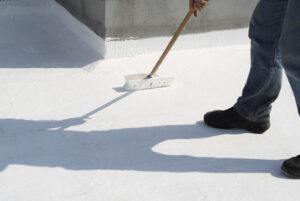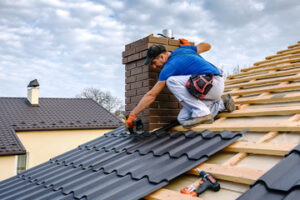The roof protects buildings from rain, snow, sunlight, extremes of temperature, and wind. It can be constructed in various forms, including flat, pitched, vaulted, or domed.

Roofing contractors install and repair residential and commercial roofs. They use ladders and scaffolding to access rooftops. They must carefully navigate residential neighborhoods while working on the homes’ exteriors.
Restoration coatings are applied directly to your existing roof, eliminating the need for a messy tear off and saving you money. The liquid material seeps into any cracks or seams and seals them, creating a monolithic membrane that lasts for the life of the building and beyond. These systems can be recoated every 10+ years to extend the lifespan of your roof and improve its performance.
These systems are very cost-effective for extending the life of a commercial roof, reducing maintenance and energy costs, and enhancing energy efficiency. They are also very fast to install, allowing your business to continue operating during the process. However, it is important to note that they will not fix all issues your roof may have. For instance, if the underlying insulation or membrane is deteriorating or has been saturated, they will not stop leaks and a full replacement may be necessary.
Another key point to consider is that these coatings are not a substitute for preventative repairs or roof system inspections. They are a good solution for a roof that is approaching the end of its serviceable life and will only provide a warranty for the new coating. They will not address any underlying problems that may occur such as moisture infiltration, ponding water or musty odors, and will exclude warranty coverage for those conditions.
Before applying a restoration coating, a full infrared inspection should be performed to verify that the existing roof is structurally sound and does not have any areas of leaking or deterioration. Once these issues have been addressed, the roof should be power washed and prepped for the application of the coating. The coating is sprayed directly onto the roof, and a primer can sometimes be used but is usually not required.
The installation of a restoration coating is significantly faster than a traditional roof replacement. The project duration will vary depending on the scope of work but is usually completed within a few days minimizing disruption to your facility operations. In addition, these systems are very environmentally friendly as they do not require a roof tear off and are sprayed directly on the existing roof, utilizing the materials that are already in place.
Single-Ply
A single-ply membrane is a type of commercial roof that uses sheets of rubber and other synthetics to create a layer of protection for your building. Single-ply membranes are available in a variety of colors, materials, and thicknesses to suit your specific project needs. Two of the most popular single-ply membrane types include Thermoplastic Polyolefin (TPO) and Ethylene Propylene Diene Terpolymer (EPDM). Each has its own benefits. EPDM has been around for more than 60 years, so it has a long history of laboratory and field testing to support its performance as a commercial roofing material. TPO is newer, but it offers energy efficiency that can help lower your building’s utility costs. Both offer resistance to chemicals, moisture, and biological growth.
Single-ply systems are typically used on flat or low-sloped commercial buildings. They’re fire-resistant and have good insulation, which can help lower your heating and cooling costs year round. They’re also durable against heavy weather conditions and have a long lifespan when properly maintained and expertly installed.
Single ply membranes can be mechanically attached, fully adhered, or self-adhered. They’re usually made from either thermoplastic or thermoset plastics. The difference between the two is that thermoplastics can be melted and reshaped, while thermoset plastics are permanent once they’re cured. Single-ply membranes come in black or white. The white versions are more reflective and can help keep the building cooler, while the black ones absorb more of the sun’s rays.
Some of the downsides to single-ply membranes include their susceptibility to punctures, limited aesthetic options, and longevity concerns. Additionally, they can have issues with seam failure, which may result in standing water or air infiltration.
When it comes to installing a single-ply system, your pro will mechanically attach the membrane to the cover board and then apply a layer of adhesive and seam tape to the seams. If you choose a fully adhered or self-adhered option, your pros will first secure the insulation to the roof deck and then use adhesives to glue the single-ply membrane to the insulation. The process takes longer and requires specific temperatures and waiting periods to cure.
TPO
TPO stands for Thermoplastic Polyolefin and is a single-ply membrane roofing material that is flexible, energy-efficient and durable. It’s a popular choice for commercial roofs due to its versatility and ease of installation. In addition to its durability, TPO’s reflective surface helps decrease your energy costs by deflecting UV rays. It’s also resistant to chemicals and punctures. This makes it a great option for flat or low-slope roofs. TPO is available in various thicknesses and widths, so you can choose the option that best suits your building.
When installing TPO, it’s important to prep the roof to ensure the material adheres and performs well. The surface should be cleaned thoroughly and any existing covering removed before laying the new membrane. After a sheet of TPO is placed on the roof, it should be set and secured using either mechanical tools or adhesive. Once it’s firmly anchored, the overlapping edges should be heat welded with a hot air gun or other heated tool to seal the seams and create an insulated barrier.
If you opt to use mechanical attachment, it’s crucial that you use the right fasteners and do so in a way that doesn’t leave too much space between them. These details will impact how long your TPO roof lasts and its effectiveness. You can also choose to have a professional roofer heat weld the seams instead, which will result in better durability and refined leak protection.
TPO is a relatively new roofing material, so it doesn’t have the same track record as some of its counterparts. However, it’s highly affordable, works in most climates and is very versatile. It’s a great option for those looking to get the most out of their budget while getting a quality roof.
In order to repair a TPO roof, you need to catch damage early before it worsens. A professional roofer will be able to determine the extent of the damage and recommend the most effective solution. This may include repairing the damaged area, replacing it or installing a completely new roof.
Metal
Metal roofing is gaining popularity for its ability to add beauty and durability, as well as help reduce energy costs. It’s available in a wide range of colors and textures, so homeowners can find a look that fits their aesthetic preferences. The roofing can also boost a home’s resale value. However, it’s important to understand the process and installation requirements before hiring a contractor. This will ensure the job is completed correctly and in compliance with local regulations and standards.
The first step in installing a metal roof is to get the correct measurements for the project. This may require climbing onto the roof to take the measurements, so it’s important to use caution when doing so and follow safety practices. Once the measurements are complete, it’s time to start putting on the panels. It’s important to work in rows, overlapping each panel as you go. This will create a better seal and prevent water from pooling in areas where there’s a lack of overlap. It’s also important to ensure the panels are properly seated. If they aren’t, the roof will not have a proper seal.
Once the panels are in place, it’s time to install the gable flashing. This is metal trim that covers joints where different sections meet on the roof. It should be cut to size and secured using neoprene washer head screws. The screws should be driven to seat flat on the roof, as opposed to being over-tightened. Over-tightening can cause the screws to rust or become dislodged over time.
Zinc is one of the most popular options for residential metal roofing due to its affordability and longevity. It can be used in all weather environments and has the added benefit of being highly recyclable. It is also lightweight, making it a good option for homes with low structural capacity or those in earthquake zones.
Steel is another common choice for residential metal roofing. It’s a durable solution that is often used in commercial buildings, but it’s becoming more common for residential projects as well. It’s a cost-effective solution that can be painted to mimic the appearance of Copper, Zinc, or Weathered Steel.






